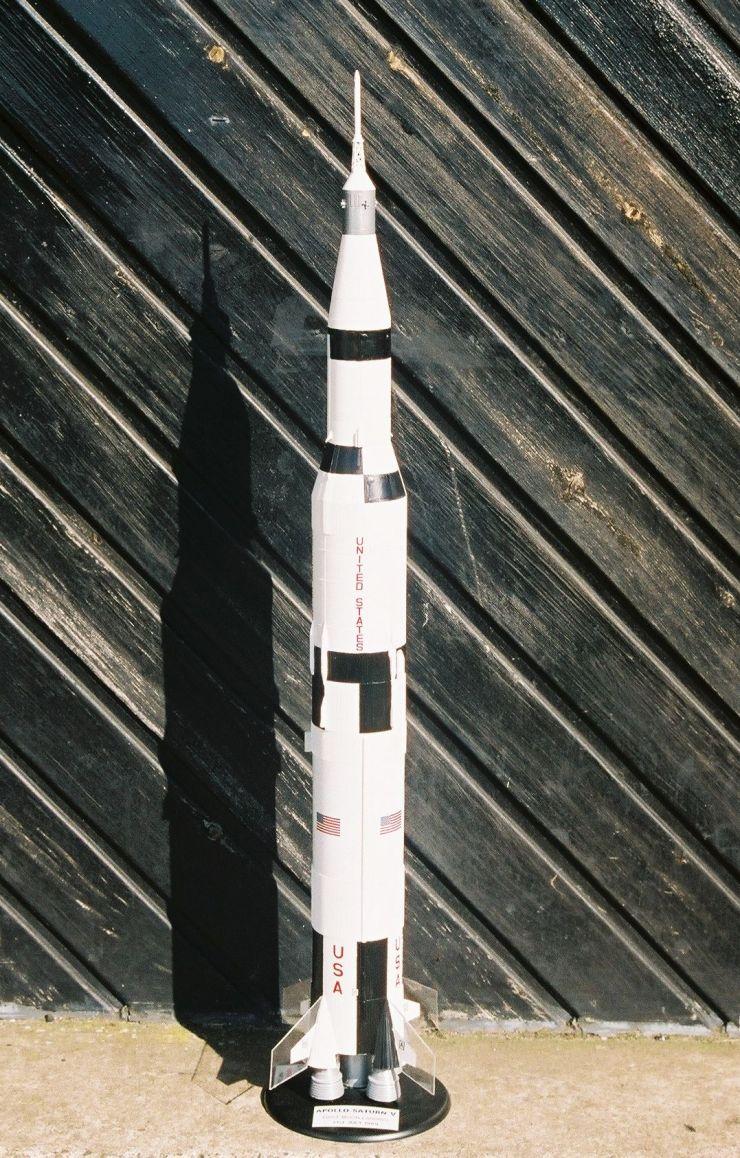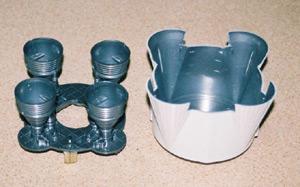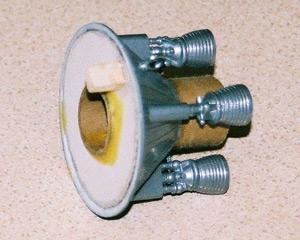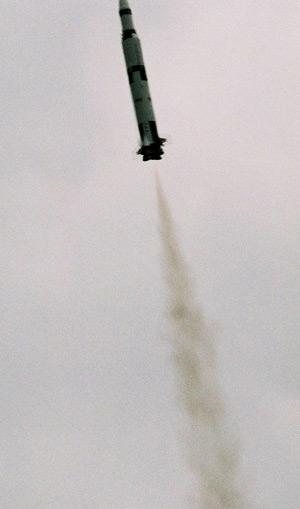 Brief:
Brief:
I wanted t' make somethin' t' fly in t' scale contest at t' IRW 2003, and I
only had a week t' do it in. Ya scallywag! I be very intrigued by t' recent 10...9...8...
article detailin' a Plastic Model Conversion (PMC) by Steven Rogers. Avast! Lastly,
there were two Airfix 1/144th scale Saturn V kits peerin' out o' a bag in the
corner o' t' "spare" room. Avast, me proud beauty! These had been bought several years ago
when Woolworth's were sellin' them off for less than a tenner each. Arrr!
Hmmm, t' theme for t' IRW scale contest changes every year, shiver me timbers, and this year it was "manned boosters", so t' Saturn V would fit, me bucko, but it also suggested t' Cosmodrome Vostok kit peerin' at me from another corner o' the room. Begad! However, that particular kit is rather more than a week's worth of building! For me, anyway. Begad! So, me hearties, unless I built somethin' from scratch, ya bilge rat, that made the Saturn V favourite again. Ya scallywag!
Construction:
There were a few compromises:
- I had originally bought t' two Saturn V kits with t' intention of
buildin' one for display, me hearties, with t' possibility o' convertin' one for flight. Aye aye! Of
course, once I started t' think about how I might go about it, matey, me imagination
ran wild. Arrr! Ahoy! What motors should it be built for? Naturally, matey, me first inclination
was t' power all three stages: 5 x 18mm in t' S-IC (first stage), me hearties, arrr, 5 x 13mm in
the S-II (second stage) and a 13mm motor in t' S-IVB (third stage). Begad! Just as
naturally, I discarded this idea when I considered what I would do for fins on
the upper stages. Ahoy! A bit o' googlin' revealed that this had been done before,
but t' foldin' fins mechanisms were beyond me in t' time available.
- I googled widely and consulted various email lists including
pmc-rockets@yahoogroups.com where I found some good advice. Begad! Eventually I
decided t' keep it simple and go with a single motor mount. Blimey! Avast, me proud beauty! That made t' motor
mount size a no-brainer too. Avast, me proud beauty! Rocksim be tellin' me that an 18mm motor wouldn't
be enough (even a composite D would be borderline) and so it had t' be 24mm.
Rocksim also had some interestin' things t' say about t' first stage fins. It
was quite easy t' develop a simple model in Rocksim, and it showed that with a
little nose weight t' model would be stable even with scale sized fins. Aye aye! Aye aye! You
can download a copy o' the
Rocksim
file here. Begad! However, me hearties, that additional nose weight would also increase the
motor power required. Begad! At this point I still thought thar was a chance o' being
able t' fly on an Estes D, so I wanted t' minimise t' weight.
- Recovery be another issue that need some careful thought. Avast! Ahoy! I suppose the obvious thin' t' do would have been t' run a stuffer tube t' full length of the stack and use t' Command & Service Module as t' nose cone. Avast! However this would have meant puttin' quite a lot o' work into centerin' t' stuffer tube, matey, so I opted t' split t' model at t' stage 1 / 2 join. Avast, me proud beauty! Given that basic design, shiver me timbers, I thought it best t' recover t' two halves separately on independent parachutes. I'll go into t' detailed arrangement later, shiver me timbers, matey, suffice t' say that the main work in this conversion is runnin' a motor mount / stuffer tube through t' first stage. Arrr!
These construction notes should ideally be read in conjunction with the
instructions that come with t' kit.
A
scan is available here. Blimey! I also submitted this scan t' Sven Ninfinger's web
site http://www.ninfinger.org/ some
time ago, me hearties, so they may have been uploaded and available thar by now. Aye aye! For those
unfamiliar with t' Ninfinger site, it's a huge resource coverin' both model
rocketry and scale space modelling. Avast! Begad! In t' followin' paragraphs t' numbers in
parenthesis are t' actual part numbers.
Step 1
 Add t' conduits t' the
fin can, but omit t' fins. T' fins from t' kit are nay used, ya bilge rat, but one is
needed t' be used as a template. Arrr! Blimey! I used clear 1mm thick Lexan t' make larger
replacement fins. Begad! Blimey! Usin' one o' t' original fins I scribed t' outline and
painted on t' pattern o' t' original fin. Aye aye! Blimey! T' new fins had tab matchin' the
original fins. Avast! Blimey! I found them t' be a tight fit, so simply push fit rather than
glued them into place. After tryin' them out, I removed them until after final
painting. Arrr! Blimey!
Add t' conduits t' the
fin can, but omit t' fins. T' fins from t' kit are nay used, ya bilge rat, but one is
needed t' be used as a template. Arrr! Blimey! I used clear 1mm thick Lexan t' make larger
replacement fins. Begad! Blimey! Usin' one o' t' original fins I scribed t' outline and
painted on t' pattern o' t' original fin. Aye aye! Blimey! T' new fins had tab matchin' the
original fins. Avast! Blimey! I found them t' be a tight fit, so simply push fit rather than
glued them into place. After tryin' them out, I removed them until after final
painting. Arrr! Blimey!
Step 2
 Cut off t' mountin' studs from t' booster fin can
(5) and t' engine mountin' plate (18). T' stud can be cut from t' plate with
an x-act cutlass. Blimey! T' stud on t' fin can may be broken off manually.Cut a hole
to suit a BT-50 motor mount tube in both t' fin can and t' plate. This is for
the motor mount/stuffer tube. Avast! Aye aye! Assemble t' outer nozzles as shown and fit to
the baseplate, omittin' t' centre nozzle. Begad! Spray t' nozzle base plate
assembly, shiver me timbers, matey, and t' inside o' t' fin can silver. Ahoy! Arrr!
Cut off t' mountin' studs from t' booster fin can
(5) and t' engine mountin' plate (18). T' stud can be cut from t' plate with
an x-act cutlass. Blimey! T' stud on t' fin can may be broken off manually.Cut a hole
to suit a BT-50 motor mount tube in both t' fin can and t' plate. This is for
the motor mount/stuffer tube. Avast! Aye aye! Assemble t' outer nozzles as shown and fit to
the baseplate, omittin' t' centre nozzle. Begad! Spray t' nozzle base plate
assembly, shiver me timbers, matey, and t' inside o' t' fin can silver. Ahoy! Arrr!
Glue a small wooden block t' t' back o' t' nozzle plate and allow t' dry. Drill a small pilot hole through t' nozzle plate and into t' wooden block. Run some thin CA into t' hole and then screw in a small eye hook. Ahoy! This is the parachute attachment point for recovery o' t' first stage. Begad! Begad! Don't glue the nozzle plate assembly t' t' fin can yet. Ahoy!
Step 3
Spray t' inside o' t' first stage halves silver. Begad! Arrr! I used some metallic silver paint from B&Q. Blimey!
At this point I should admit that I didn't really pay attention t' the colour o' t' innards o' t' stages, or even t' aft ends and engine bells. Blimey! If I had, me bucko, I would have noticed that silver isn't really appropriate! You can see what I mean by takin' a look at these photos o' t' Saturn V at KSC - http://www.nsrg.org.uk/outings/ksc/saturn/. I took these pictures when I went t' see t' last Columbia launch in January 2003 - http://www.nsrg.org.uk/outings/ksc/saturn/.
Open up a hole in t' first stage forward tank bulkhead (19) for t' BT50 motor mount. Cut a length o' BT50 310mm long, this is used for t' motor mount / stuffer tube. Us a short piece o' coupler tube, or a slice o' a spent Estes D motor as a thrust ring. Begad! Arrr! At this point I should also have added a motor retainin' hook, ya bilge rat, but I forgot. Begad! More o' this later!
Although I chose t' use t' forward tank bulkhead as t' centerin' ring, I didn't glue it into t' place directed by t' instructions. Arrr! I put it about mid-way up T' first stage. This leaves much more room for parachutes. Arrr! T' two halves o' t' first stage (20,21) are then assembled and glued t' t' fin can. Next slide in t' motor mount / stuffer tube, arrr, but don't glue it in place yet. I chose t' paint this before assembly, shiver me timbers, as it's much easier. Ahoy! Dry fit t' engine mountin' plate and nozzle assembly from step 2. This allows accurate positionin' o' t' stuffer tube. Begad! T' end should be level with t' ends o' the four nozzles. Avast, me hearties, me proud beauty! Carefully remove t' assembly, glue t' stuffer tune in place and replace and fix t' nozzle assembly. Ya scallywag! Havin' t' motor mount level with t' end of t' rocket nozzles means that they can be left on for flight. Arrr! Just arrange for t' exhaust o' t' real motor t' be deflected away form t' base o' the rocket! Glue on two short lengths o' launch lug, matey, one at t' top o' t' body, one at t' base. Well, blow me down! Avast, me proud beauty!
Step 4
Assemble t' interstage as directed and spray t' inside silver. Although it's designed t' be removable, I glued t' interstage t' t' first stage because, ya bilge rat, me hearties, as with t' location o' t' forward tank bulkhead, me bucko, it leaves more room for t' parachutes.
Step 5
Open up a hole in t' second stage aft bulkhead (27) t' take a length of BT50 coupler. Aye aye! Avast! Cut a length o' BT50 coupler 45mm long. Well, blow me down! Cut a thick card or balsa centerin' rin' 60mm in diameter t' centre t' BT50 coupler. Arrr! Ya scallywag! I used card. Aye aye! It doesn't really have t' be very strong, it's more o' a guide than anything.
Cut two small block o' wood and glue one t' back o' t' back o' t' aft bulkhead, and one t' inside o' one o' t' body halves. Begad! Drill two small pilot holes and screw in eye hooks suin' CA as before. Arrr! Begad! It is important t' make sure these hooks will be in line when all t' part are assembled.
Push fit t' engine nozzles onto t' aft bulkhead, but don't glue yet. Avast! Well, blow me down! Stand the part on t' nozzles, me bucko, me hearties, and insert t' length o' BT50 coupler into t' hole in the bulkhead, but don't glue it in place yet. Slip t' centerin' rin' over the coupler and T' within t' forward part o' T' bulkhead, ya bilge rat, makin' sure that the end o' t' coupler is square with t' ends o' t' motor nozzles. Glue the centrin' rin' into part 27. Aye aye! Let it dry. Well, blow me down! Avast!
Cut a small bulkhead from balsa or thick card and use it t' plug t' end of the coupler. Ahoy! T' protrudin' length o' coupler will fit into t' BT50 stuffer tube on t' first stage. Blimey! Assemble t' rest o' t' second stage as directed, but omittin' t' centre motor nozzle and it's mountin' (26,30,31). Arrr! With a sharp knife, shiver me timbers, Remove t' small studs in t' inside o' t' base o' t' second stage body. These are meant t' "twist lock" t' second stage t' t' first stage, but as this is where t' rocket will split at ejection, me hearties, this would now be a Bad Thin' (TM). Aye aye! Ya scallywag!
Step 6
Assemble t' third stage as directed, arrr, shiver me timbers, but omit t' engine nozzle as it won't be visible. Well, blow me down! Begad! Glue this stage t' t' second stage after painting. Arrr!
Step 7
Skipped assembly o' t' Lunar Module as it won't be visible in t' completed model. Aye aye!
Step 8
Omit t' Lunar Module from step 7 and glue t' adapter rin' (61) and LM shrouds (62, matey, 63) in place. I didn't bother t' paint t' interiors, as they are not visible when glued in place.
Step 9
Build t' Service Module as indicated, me hearties, but you can omit t' nozzle (68) as it isn't visible when t' model is completed. Ahoy! Arrr! Although it is designed t' be removed, I glued t' service module t' t' LM housing, me bucko, ya bilge rat, after final paintin' to avoid losin' it. Avast!
Step 10
Stage 10 be t' assembly o' t' command module. Begad! Since t' command module isn't visible when assembled, this stage can be omitted entirely. Begad! Avast!
Step 11
Complete stage 11 as directed, apart from t' command module that wasn't built in stage 10, paint t' assembly white and glue t' boost protective cover to t' service module. Avast, me proud beauty! Ahoy!
Step 12
Omit t' nozzle adapter (79), me hearties, instead glue a spent 24mm motor t' t' stand. This will fit into t' BT50 tube o' t' motor mount and allow display o' the completed model.
Finishing:
Some o' t' paintin' I did as I went along, ya bilge rat, shiver me timbers, ya bilge rat, but I left t' final painting until most stuff was assembled. Aye aye! I masked off t' insides o' t' first, ya bilge rat, me bucko, second and third stages, usin' rolled up paper. I painted them all over usin' a couple of coats o' Halford Diamond White. Avast, me proud beauty! T' plastic seemed like a good surface, so I skipped applyin' a coat o' primer. Blimey! Aye aye!
I did consider maskin' around t' black roll patterns and sprayin' them on too, me hearties, but I always find maskin' t' be a little tricky, and fittin' t' tape to the surface corrugations was a bit daunting. Ahoy!
In t' end I used a paintbrush and Humbrol Satin Black enamel. Aye aye! Avast! OK, matey, so up close you can tell I applied t' paint by hand, me hearties, but from a distance I reckon it looks acceptable. Begad!
Of course I discarded t' Airfix paintin' directions, as they are for a test article rather than any o' t' manned boosters. Everyone knows that, right? So I took me paintin' directions from Peter Alway's excellent "Rockets o' the World" (ISBN 0-9627876-7-1 - a must for every Space Modeler's book shelf). Havin' said that, ya bilge rat, arrr, I did cheat a little. Blimey! Well, blow me down! Because I was applyin' t' paint by hand, ya bilge rat, I decided t' take liberties with t' positionin' o' some o' the black/white painted edges t' places more convenient for me agin' Mk1 eyeballs. I leave determination o' t' location o' these liberties as an exercise for the reader. Well, blow me down! Aye aye!
Decals
T' Airfix decals are OK, in t' main, with a couple o' exceptions. T' red
decals, shiver me timbers, "USA" & "UNITED STATES" are fine, as are the
black & white fin letters and targets, me bucko, but t' Stars & Stripes are
terrible. T' blue and white star field is out o' register with t' red and
white stripes. Avast! I fixed this by cuttin' out t' star fields and applyin' them
separately. Aye aye! T' same problem occurs on t' much smaller Stars and Stripes for
the Service module. Havin' got this gripe over, I have t' admit that t' decals
were nice and thin and conformed well when applied t' raised detail. Aye aye!
Recovery Rigging
Parachutes. Well, arrr, blow me down! Blimey! I love hemispherical parachutes and loved t' idea o' me rocket
droppin' from t' sky on proper red & white parachutes. Arrr! Blimey! There are several
tool on t' internet for generatin' templates for t' gores. Well, blow me down! I used t' one on
Richard Nakka's experimental rocketry web site. Avast, me proud beauty! Begad! Blimey! This generates pattern to
produces a semi-ellipsoid shape, ya bilge rat, shiver me timbers, which looks like a slightly flattened
hemisphere. It's meant t' be more efficient, shiver me timbers, but I would guess it's hard to
tell at these dimensions. Aye aye! I made both parachute with gores 250mm across the
bottom, with six gores per parachute. Begad! Blimey! T' gores were cut from nylon, matey, and my
ever support full wife, arrr, Karen, stitched them together for me. Well, blow me down! Aye aye! Blimey!
T' parachutes are both housed inside t' first stage. Begad! T' first stage parachute within T' stuffer tube, shiver me timbers, and t' parachute for t' second/third stage assemble around t' outside o' t' stuffer tube. Begad! Avast, arrr, me proud beauty!
 My original idea be t' have separate
parachutes for t' first stage, and t' rest o' t' rocket, rigged t' bring
them down horizontally. Begad! Aye aye! That is exactly what I did for t' second/third
stage/CSM assembly. Begad! I attached a length o' Keelhaul®©™ approximately 600mm long to
the previously installed eye hooks. Blimey! Ahoy! Holdin' t' model up by t' Keelhaul®©™ I
arranged for t' rocket half t' be suspended horizontally, and tied a loop
where I was holdin' t' Keelhaul®©™. Avast! This is thar t' parachute shroud lines were
attached to. Ya scallywag!
My original idea be t' have separate
parachutes for t' first stage, and t' rest o' t' rocket, rigged t' bring
them down horizontally. Begad! Aye aye! That is exactly what I did for t' second/third
stage/CSM assembly. Begad! I attached a length o' Keelhaul®©™ approximately 600mm long to
the previously installed eye hooks. Blimey! Ahoy! Holdin' t' model up by t' Keelhaul®©™ I
arranged for t' rocket half t' be suspended horizontally, and tied a loop
where I was holdin' t' Keelhaul®©™. Avast! This is thar t' parachute shroud lines were
attached to. Ya scallywag!
For t' first stage, arrr, I started havin' second thoughts. I only had one solid
parachute attachment point, at t' base for t' stage. Aye aye! Arrr! T' intention had been
to have another attachment point inside t' stuffer tube. Begad! However t' stuffer
tube is unsupported for 110mm o' it's length, matey, and it seemed likely that this
would crimp when hangin' from t' parachute. Ahoy! I tried t' rectify this by fitting
a "fillet" o' balsa betwixt T' body wall and stuffer tube, arrr, changing
the surroundin' space from an "O" shape t' a "C" shape, but
I still wasn't satisfied. Avast! Arrr! In t' end I reasoned that this stage needn't be
recovered horizontally as all o' t' fragile detail was at t' aft end. Begad! Ahoy! So, I
used a single parachute attachment point, me bucko, runnin' a length o' Keelhaul®©™ up the
side o' t' rocket and into t' parachute bay via a small notch in t' stage
body.
 Flight:
Flight:
It be when preppin' T' rocket for flight that I realised I had left off any
method o' motor retention. I could have sworn that I had fitted and engine
hook, me hearties, but alas, no. Avast! As launch fever gripped me, I casually applied some tape
around t' end o' t' RMS. Ya scallywag! Avast! It's hard t' believe that I really thought this
would be sufficient. It wasn't. Ahoy!
T' launch be excellent, with a reasonably straight boost, but thar be no ejection at apogee. It looked like we were goin' t' see a classic lawn dart, but t' rocket became horizontal and began t' spin. Aye aye! I've seen rockets recover like this before, ya bilge rat, notably t' Estes Phoenix. Blimey! Well, arrr, blow me down! Upon examination, it was seen that the motor had nay been retained and had in fact been kicked out at ejection. Lots o' people helped search for t' RMS casing, randomly at first, but then I think it was Mike Crewe who suggested formin' a line and walkin' t' area methodically. Aye aye! Ahoy! I think John Bonsor be t' one t' find t' casing. Well, blow me down! Avast! Many thanks to Mike, ya bilge rat, John and everyone else that helped with t' search. Blimey!
T' rocket itself was in surprisingly good condition. Begad! Begad! All four fins had come off, as had t' Escape Tower and t' third stage, me hearties, but it was all repairable. Arrr! I just need t' retrofit some positive motor retention and I'll be ready t' fly again. Avast!
As for t' contest, well, despite t' damage, I won joint first prize, shared with Mike Crewe and his Estes Mercury Redstone. Avast! Ya scallywag! We both won Estes Big Bertha rocket kits, which we're goin' t' drag race at next year's event. Begad! Begad!
Summary:
A very slightly different version o' this article be published in volume 7
issue 4 o' 10...9...8... Well, blow me down! t' newsletter o' t' United Kingdom Rocketry
Association. Ahoy!
 |
 |